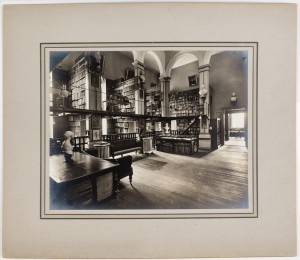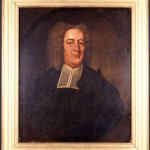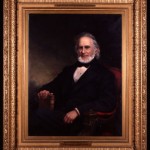The following post comes to us from AAS reader Peter MacInerney.
Early in January 1855, a Concord-based free-lance writer, occasional surveyor, and sometime lecturer, visited the American Antiquarian Society at its then-new building. This second Antiquarian Hall had been completed little more than one year before, after the Society outgrew its original building. The visitor recounted that day as follows:
Jan. 4. To Worcester to lecture. Visited the Antiquarian Library of twenty-two or twenty-three thousand volumes. It is richer in pamphlets and newspapers than Harvard. One alcove contains Cotton Mather’s library, chiefly theological works, reading which exclusively you might live in his days and believe in witchcraft. Old leather-bound tomes, many of them black externally as if they had been charred with fire. Time and fire have the same effect. Haven said that the Rev. Mr. Somebody had spent almost every day the past year in that alcove.
The visitor who wrote this account was Henry Thoreau (1817-1862), author of the just-published Walden, or, Life in The Woods (1854).
In Thoreau’s account of his visit, he refers to Cotton Mather (1663-1728), an American icon (unfairly) stigmatized as a witch-hunter. Mather was a Boston Puritan pastor and owner of a library said to hold more volumes than any other in North America. Many Mather items — written by Cotton and other Mathers or held in their libraries — are now housed at the Society’s current building (built in 1909 and expanded most recently in 2001).
In the quote above, Thoreau also referred to “Haven,” or Samuel Foster Haven (1806-1881). Haven had been the Society’s Librarian since 1838. The “Rev. Mr Somebody” observed by Thoreau, and described by Haven, remains unidentified.
The interior of the 1853 Antiquarian Society building that Thoreau visited and the reverend gentleman patronized — handling perhaps hundreds of Mather’s old leather tomes, black with time — appeared as shown in the photograph below.
 The Antiquarian Society’s Mather holdings include two groups: the Mather Family Collection contains works written by members of the Mather family, including Cotton Mather, and the Mather Family Library consists of works once owned by Mather family members. Some four hundred eighty-nine books, pamphlets, and sermons written by Cotton Mather are listed in the Society’s online catalog, and many are available digitally on Early American Imprints, Series 1: Evans Digital Edition.
The Antiquarian Society’s Mather holdings include two groups: the Mather Family Collection contains works written by members of the Mather family, including Cotton Mather, and the Mather Family Library consists of works once owned by Mather family members. Some four hundred eighty-nine books, pamphlets, and sermons written by Cotton Mather are listed in the Society’s online catalog, and many are available digitally on Early American Imprints, Series 1: Evans Digital Edition.
Society-held items written by Cotton Mather certainly do include “chiefly theological works,” as Thoreau may have learned from Haven. Cotton Mather was concerned professionally with matters of belief and witness and doctrine. He was the son of the Reverend Richard Mather, whom Cotton succeeded as minister of the North Church and served some forty-three years.
Mather’s most famous work – though, like most, rarely read — is titled Magnalia Christi Americana (1702), an account of the great progress of Christ in the New World. The Society holds several American imprint editions of that work. But the breadth of the Society’s collection of American imprints of Cotton Mather’s writings reveals the extent of Mather’s career as an Early American Protestant cleric. His A, B, Cs of Religion instructed children, converts, and their teachers. As wartime minister, he delivered “A Discourse” titled Souldiers Counselled and Comforted (1689) addressed to “Forces engaged in the JUST WAR…against the Northern and Eastern Indians.” Mather preached hundreds of sermons, some of which were printed at his own expense and distributed free. What’s more, Cotton Mather’s writings held at the Antiquarian include works of natural philosophy and epidemiology, including urging of inoculation against smallpox. Such achievements that earned Mather election as a Fellow of England’s Royal Society.
Much of the scholarship about Cotton Mather was produced in part by means of the two groups of American Antiquarian Society holdings: the Mather Family Collection and the Mather Family Library (the single largest gathering in the world of texts written and owned by Mathers). These works include Kenneth Silverman’s 1984 Pulitzer Prize-winning biography, The Life and Times of Cotton Mather, and William Van Arragon’s forthcoming Cotton Mather as American Icon.
If Henry Thoreau and Librarian Samuel Foster Haven and Reverend Mr. Somebody were to return to the Society today, they would find Cotton Mather’s old, black tomes not in an open, browsable alcove, but stored safely in a cool, climate-controlled vault. Here they sit, racked in hand-cranked, movable grey steel stacks, resting upon quiet shelves. But now the Concord visitor, the Worcester Librarian, and the Reverend could also search, retrieve and download virtual Mather volumes at a speed near light under the Antiquarian Society’s “generous dome.” Or if their research required it, such visitors may still obtain curatorial permission to examine the original volumes that were handled and written and read by Cotton Mather three centuries ago — old, leather-bound books, black externally, as if charred by a fire within Cotton Mather, a blaze bursting from the Boston pen and pulpit of an ardent “souldier” and American icon.



Well, here I am, today, reading Mather’s Magnalia Christi Americana! Nice coincidence. I’m feeling the heat, even without seemingly scorched and blackened covers. Great post!
Fascinating. I learned so much, in one sitting, hundreds of miles away from the time-charred volumes but feeling as if I were there. Many thanks, Mr. MacInerney.
A couple of important corrections: 1) Cotton Mather was not the son of Richard Mather, but of Increase Mather. Richard Mather was Cotton’s grandfather. Cotton and Increase shared the pulpit of the North Church in Boston for many years. Richard was minister of the church in Dorchester. 2) Thoreau was wrong — time and fire do not have the same effect on books. Many of the books in the Mather Library may have been actually charred or blackened by the major fire in 1679 that destroyed the Mathers’ house in the North End. Silverman’s biography recounts the dramatic events, with Increase tossing stacks of books down the stairs to Cotton waiting below to rescue them. But plenty of other Mather Library books are in marvelous shape, their brown leather covers and sturdy paper holding up well after three, four, or even five centuries.